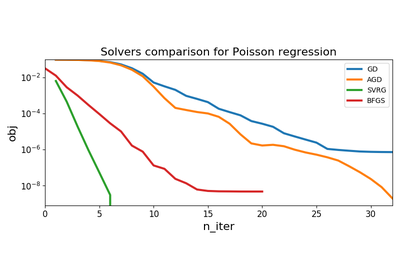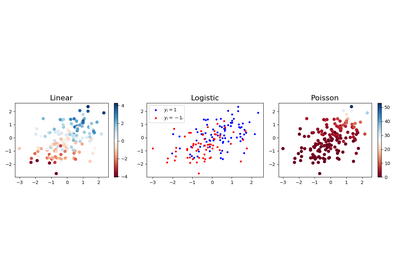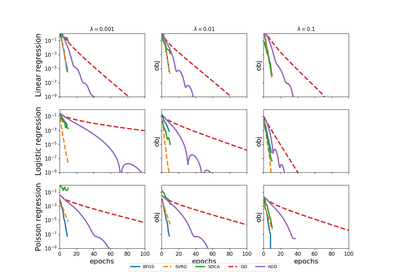tick.linear_model.SimuPoisReg¶
-
class
tick.linear_model.SimuPoisReg(weights: numpy.ndarray, intercept: float = None, features: numpy.ndarray = None, n_samples: int = 200, link: str = 'exponential', features_type: str = 'cov_toeplitz', cov_corr: float = 0.5, features_scaling: str = 'none', seed: int = None, verbose: bool = True, dtype='float64')[source]¶ Simulation of a Poisson regression model, with identity or exponential link.
- Parameters
weights :
numpy.ndarray, shape=(n_features,)The array of weights of the model
intercept :
float, default=`None`The intercept. If None, then no intercept is used
features :
numpy.ndarray, shape=(n_samples, n_features), default=`None`The features matrix to use. If None, it is simulated
n_samples :
int, default=200Number of samples
link :
str, default=”exponential”Type of link function
if
"identity": the intensity is the inner product of the model’s weights with the features. In this case, one must ensure that the intensity is non-negativeif
"exponential": the intensity is the exponential of the inner product of the model’s weights with the features
features_type :
str, default=”cov_toeplitz”The type of features matrix to simulate
If
"cov_toeplitz": a Gaussian distribution with Toeplitz correlation matrixIf
"cov_uniform": a Gaussian distribution with correlation matrix given by .5 * (U + U.T), where U is uniform on [0, 1] and diagonal filled with ones.
cov_corr :
float, default=.5Correlation to use in the Toeplitz correlation matrix
features_scaling :
str, default=”none”The way the features matrix is scaled after simulation
If
"standard": the columns are centered and normalizedIf
"min-max": remove the minimum and divide by max-minIf
"norm": the columns are normalized but not centeredIf
"none": nothing is done to the features
seed :
int, default=NoneThe seed of the random number generator. If
Noneit is not seededverbose :
bool, default=TrueIf
True, print thingsdtype :
{'float64', 'float32'}, default=’float64’Type of the generated arrays. Used in the case features is None
- Attributes
features :
numpy.ndarray, shape=(n_samples, n_features)The simulated (or given) features matrix
labels :
numpy.ndarray, shape=(n_samples,)The simulated labels
time_start :
strStart date of the simulation
time_elapsed :
intDuration of the simulation, in seconds
time_end :
strEnd date of the simulation
-
__init__(weights: numpy.ndarray, intercept: float = None, features: numpy.ndarray = None, n_samples: int = 200, link: str = 'exponential', features_type: str = 'cov_toeplitz', cov_corr: float = 0.5, features_scaling: str = 'none', seed: int = None, verbose: bool = True, dtype='float64')[source]¶ Initialize self. See help(type(self)) for accurate signature.


